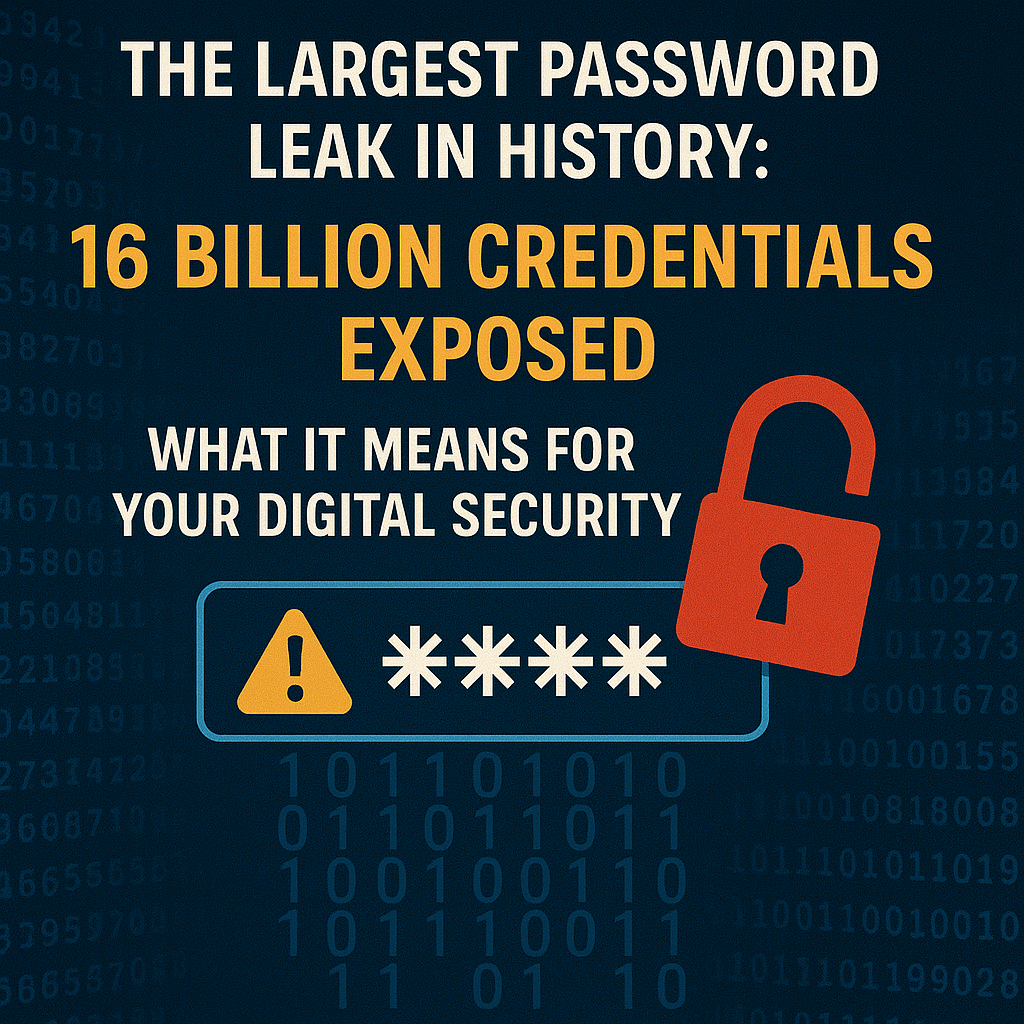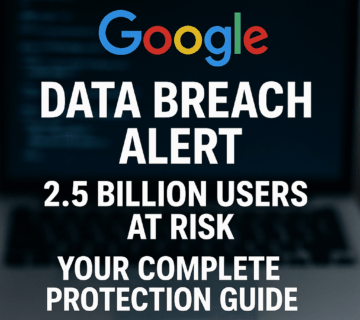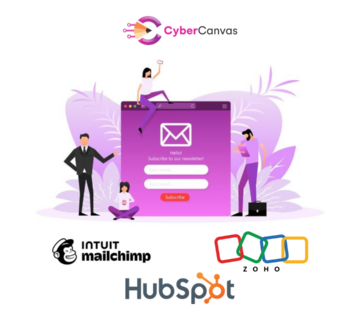The Largest Password Leak in History: 16 Billion Passwords Leaked – What It Means for Your Digital Security
Published: June 21, 2025 | Cyber Canvas Security Blog
Introduction: A Digital Security Nightmare Unfolds
In what cybersecurity experts are calling the most devastating credential leak in internet history, security researchers have discovered an unprecedented breach exposing 16 billion login credentials across 30 separate databases. This catastrophic event affects users of virtually every major online platform, including Facebook, Instagram, Gmail, Apple services, and countless other digital services that millions rely on daily.
The magnitude of this breach cannot be overstated. With approximately 5.5 billion internet users worldwide, this leak potentially compromises multiple accounts for every person online, creating a perfect storm for cybercriminals seeking to exploit stolen credentials for financial gain, identity theft, and corporate espionage.
The Scope of the Breach: Understanding the Massive Scale
What Makes This Breach Unprecedented
Unlike previous data breaches that typically involve single companies or platforms, this leak spans across:
- 30 distinct databases containing stolen credentials
- Massive variation in size: From databases with tens of millions of records to colossal collections exceeding 3.5 billion credentials each
- Fresh intelligence: Nearly all datasets were previously unreported, meaning this isn’t recycled old data
- Universal platform coverage: Every major online service category affected
Platforms and Services at Risk
The exposed credentials encompass virtually every digital service imaginable:
Social Media Giants
- Facebook and Instagram login details
- Twitter/X account credentials
- LinkedIn professional profiles
- TikTok and Snapchat accounts
Email and Communication Services
- Gmail, Yahoo, and Outlook accounts
- Telegram messaging app credentials
- WhatsApp linked accounts
- Corporate email systems
Professional and Developer Platforms
- GitHub developer accounts
- Microsoft Office 365 credentials
- Slack workspace logins
- Project management tools
Financial and E-commerce
- Online banking portals
- PayPal and digital wallet services
- Amazon and eBay accounts
- Cryptocurrency exchange platforms
Government and Institutional Services
- Government portal access
- Educational institution accounts
- Healthcare system logins
- Municipal service platforms
How This Breach Happened: The Technical Reality
Infostealer Malware: The Silent Threat
Security researchers have identified that this massive collection appears to originate from infostealer malware – malicious software designed to silently harvest sensitive information from infected devices. This sophisticated malware operates by:
- Silent Installation: Often bundled with seemingly legitimate software downloads
- Credential Harvesting: Automatically extracting saved passwords from web browsers
- Data Exfiltration: Sending stolen information to criminal servers
- Continuous Operation: Running undetected while continuously collecting new credentials
The Standard Data Format Reveals the Source
Each compromised record follows a consistent structure:
- Website URL
- Username or email address
- Associated password
- Additional metadata (cookies, tokens, session data)
This standardized format strongly suggests automated collection methods rather than targeted attacks on individual platforms, indicating the widespread deployment of credential-stealing malware across millions of devices globally.
Why This Breach Is Particularly Dangerous
Fresh Intelligence vs. Recycled Data
Previous major breaches often involved older, recycled credential dumps that criminals had been circulating for years. This new leak represents “fresh, weaponizable intelligence at scale” – meaning:
- Current passwords: Many credentials are still actively valid
- Recent tokens and cookies: Session data that can bypass some security measures
- Metadata inclusion: Additional information that makes attacks more sophisticated
- Organizational vulnerability: Companies without multi-factor authentication face immediate risk
The Cybercriminal Opportunity
With this treasure trove of current credentials, cybercriminals can execute:
Account Takeover Attacks
- Direct login using stolen credentials
- Password spraying across multiple platforms
- Automated account compromise at scale
Advanced Social Engineering
- Highly targeted phishing campaigns using real account information
- Personalized scam attempts based on platform usage
- Identity theft using comprehensive personal data
Corporate Espionage
- Business email compromise (BEC) attacks
- Insider threat simulation
- Intellectual property theft
Immediate Actions You Must Take Today
1. Emergency Password Reset Protocol
Priority Actions (Complete Within 24 Hours):
- Change passwords for all critical accounts (banking, email, social media)
- Use completely unique passwords for each platform
- Avoid using personal information in new passwords
- Implement passwords with minimum 12 characters including mixed case, numbers, and symbols
2. Enable Multi-Factor Authentication Everywhere
Essential MFA Implementation:
- Activate two-factor authentication on all supported platforms
- Use authenticator apps rather than SMS when possible
- Store backup codes in a secure location
- Configure multiple authentication methods where available
3. Implement Advanced Security Measures
Enhanced Protection Steps:
- Deploy a reputable password manager for unique credential generation
- Enable account monitoring and suspicious activity alerts
- Review and revoke unnecessary app permissions and third-party access
- Update recovery information (phone numbers, backup emails)
4. Conduct Security Health Assessment
Account Audit Checklist:
- Use “Have I Been Pwned” to check credential compromise status
- Review recent login activity across all platforms
- Monitor bank and credit card statements for unauthorized transactions
- Check credit reports for suspicious new accounts or inquiries
Long-Term Security Strategy: Beyond the Immediate Response
Building Resilient Digital Defense
Proactive Security Measures:
- Regular Security Audits: Monthly review of account security settings
- Software Hygiene: Keep all devices and applications updated with latest security patches
- Network Security: Use secure, encrypted connections (HTTPS) and avoid public Wi-Fi for sensitive activities
- Email Vigilance: Scrutinize all email links and attachments, even from known contacts
Corporate Security Considerations
Business Protection Requirements:
- Implement enterprise password management solutions
- Deploy endpoint detection and response (EDR) systems
- Conduct regular employee security awareness training
- Establish incident response procedures for credential compromise
Industry Impact and Future Implications
The Evolving Threat Landscape
This massive breach highlights several critical trends in cybersecurity:
Malware Sophistication: Infostealer malware has become increasingly sophisticated, often evading traditional antivirus solutions while operating silently for extended periods.
Scale of Criminal Operations: The coordination required to manage 30 separate databases suggests highly organized cybercriminal enterprises with substantial technical resources.
Platform Vulnerability: Even major tech companies struggle to protect users from credential theft that occurs on end-user devices rather than corporate servers.
Regulatory and Legal Consequences
Potential Outcomes:
- Increased regulatory scrutiny of platform security measures
- Enhanced legal requirements for breach notification
- Stricter penalties for inadequate user data protection
- Industry-wide security standard implementations
Frequently Asked Questions (FAQ)
Q: How do I know if my specific accounts were compromised in this breach?
A: Unfortunately, the full list of affected accounts hasn’t been publicly released due to security concerns. However, you can:
- Check your email addresses on “Have I Been Pwned” (haveibeenpwned.com)
- Monitor your accounts for suspicious activity
- Assume your credentials may be compromised and take preventive action
- Enable security alerts on all your important accounts
Q: Is changing my password enough to protect my accounts?
A: Changing passwords is essential but not sufficient alone. You should also:
- Enable multi-factor authentication on all accounts
- Use unique passwords for each platform
- Monitor account activity regularly
- Update security questions and recovery information
- Consider using a password manager for better security
Q: What should I do if I’ve already noticed suspicious activity on my accounts?
A: Take immediate action:
- Change passwords immediately
- Log out of all devices and sessions
- Contact the platform’s support team
- Review and secure linked accounts
- Monitor financial accounts closely
- Consider freezing credit reports temporarily
- Document any unauthorized activities for potential legal action
Q: How can businesses protect themselves from similar breaches?
A: Organizations should implement:
- Enterprise-grade endpoint security solutions
- Regular employee security training
- Multi-factor authentication for all business accounts
- Network segmentation and access controls
- Incident response plans for credential compromise
- Regular security audits and penetration testing
Q: Will this type of massive breach happen again?
A: Unfortunately, yes. Cybersecurity experts predict:
- Infostealer malware will continue evolving
- Criminal organizations will become more sophisticated
- New attack vectors will emerge regularly
- The value of stolen credentials will drive continued criminal activity
Q: What’s the difference between this breach and previous major data breaches?
A: This breach is unique because:
- It spans multiple platforms rather than targeting a single company
- The credentials are fresh and currently valid
- It includes metadata that makes attacks more sophisticated
- The scale exceeds any previous credential leak in history
- It demonstrates the effectiveness of modern infostealer malware
Q: How long will it take for these stolen credentials to become useless?
A: The timeline varies:
- Credentials remain dangerous until users change their passwords
- Some tokens and session data may expire naturally within days or weeks
- However, many users never change passwords, keeping credentials valuable indefinitely
- Cybercriminals may continue using this data for months or years
Q: Should I avoid using certain platforms until this is resolved?
A: Rather than avoiding platforms:
- Secure your existing accounts immediately
- Use multi-factor authentication before accessing sensitive accounts
- Avoid accessing accounts on public or unsecured networks
- Monitor account activity more frequently
- Focus on securing rather than abandoning your digital presence
How Cyber Canvas Can Protect Your Digital Future
At Cyber Canvas, we understand that today’s cybersecurity landscape demands more than reactive measures—it requires proactive, comprehensive digital defense strategies. This unprecedented 16-billion credential leak demonstrates exactly why organizations and individuals need expert cybersecurity guidance.
Our Comprehensive Security Solutions
For Individuals:
- Personal Cybersecurity Audits: Complete assessment of your digital footprint and vulnerability points
- Secure Digital Identity Management: Implementation of enterprise-grade security measures for personal use
- Ongoing Security Monitoring: Continuous surveillance of your accounts and credentials across the dark web
- Emergency Response Services: Immediate assistance when security breaches occur
For Businesses:
- Enterprise Security Architecture: Design and implementation of multi-layered security frameworks
- Employee Security Training: Comprehensive programs to prevent infostealer malware infections
- Incident Response Planning: Preparation and execution of breach response procedures
- Compliance and Risk Management: Ensuring your organization meets industry security standards
Why Choose Cyber Canvas?
Proven Expertise: Our cybersecurity professionals have decades of combined experience defending against evolving threats like infostealer malware and credential harvesting operations.
Cutting-Edge Technology: We deploy the latest security tools and techniques to stay ahead of cybercriminal innovations.
Personalized Approach: Every client receives customized security solutions designed for their specific risk profile and business requirements.
24/7 Support: Cyber threats don’t follow business hours, and neither do we. Our security operations center provides round-the-clock monitoring and response.
Take Action Today
Don’t wait for the next massive breach to impact your digital security. Contact Cyber Canvas today to schedule your comprehensive security assessment and begin building robust defenses against tomorrow’s cyber threats.
Ready to secure your digital future?
- Visit our website at www.cybercanvas.in
- Call our security hotline: +91 9996965467
- Email our experts: info@cybercanvas.in
Your digital security is our mission. Let Cyber Canvas be your trusted partner in navigating the complex world of cybersecurity threats and building an impenetrable digital defense strategy.
Stay informed about the latest cybersecurity threats and protection strategies by subscribing to the Cyber Canvas Security Blog. Together, we can build a more secure digital world.







[…] has a proven track record of high-profile attacks, having previously breached AT&T Wireless, Mashable, Microsoft, Santander, Ticketmaster, and […]